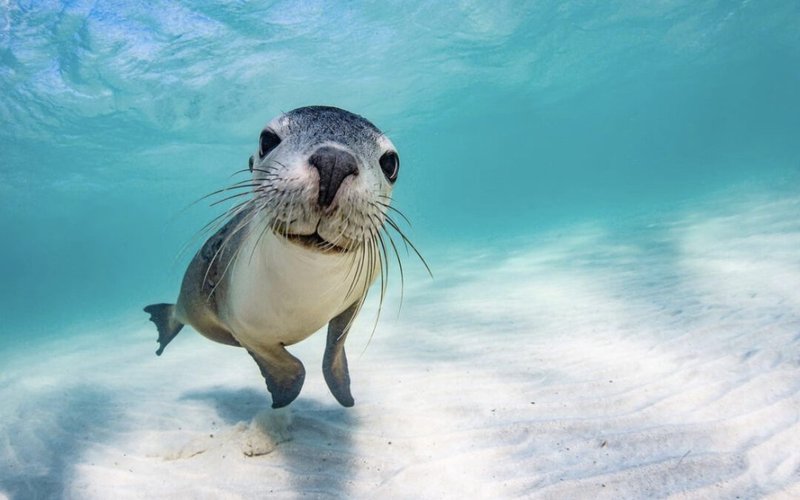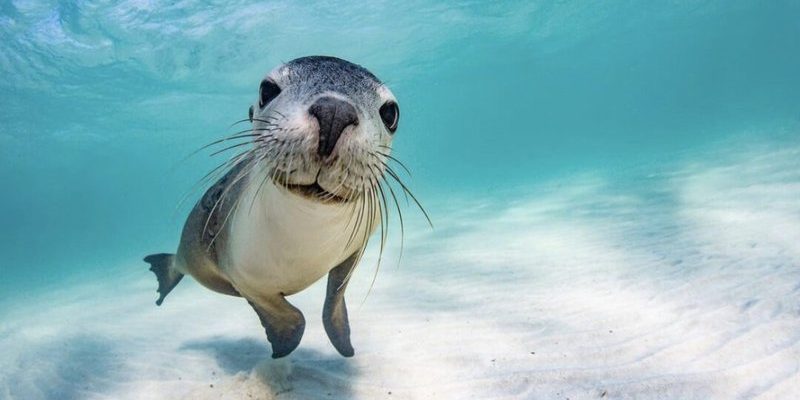
Imagine being underwater where everything looks different. The light filters through the water, creating a magical, wavy world. This is where sea lions spend a lot of their time. They need to find food, mates, and safe places to rest, all while avoiding dangers. So, how do they do it? Let’s dive into the incredible ways sea lions navigate and communicate, exploring the tools they use and the strategies they develop.
How Sea Lions Use Their Senses to Navigate
Sea lions are equipped with amazing senses that help them find their way in the ocean. They rely heavily on their sense of sight and hearing, both of which are finely tuned for life in water.
Vision:
Underwater, everything is blurry and hazy to us humans, but sea lions have adapted their eyes for this environment. Their eyes can focus well both above and below the surface, allowing them to see prey like fish and squid. The light plays tricks underwater, creating patterns and shadows. Sea lions are keen observers, using their vision to spot potential food sources from a distance.
Hearing:
You might be surprised to learn that sea lions have an excellent sense of hearing. They can detect sounds from a long way away, helping them pick up on the calls of other sea lions or even the sound of thriving fish schools nearby. Their ears are designed to close when they dive, preventing water from entering, but they can still hear vibrations. This ability is super useful when they’re hunting, as they can track sounds to locate their meal.
The Role of Echolocation in Navigation
While sea lions aren’t echolocators like dolphins or bats, they still use their environment to help them navigate. You might be wondering, “How do they find food in murky waters?” Here’s the thing: sea lions gather information from the echoes of sounds they produce, mixed with their sharp hearing, to assist in navigation.
When they vocalize, the sound waves bounce off objects, creating echoes. Even though they don’t use echolocation in the same way as some animals, these echoes can provide clues about their surroundings. They can sense the size, shape, and distance of obstacles nearby, allowing them to maneuver expertly through their watery domain. For instance, if they hear a sound that bounces back quicker than expected, they might realize there’s a rock or reef nearby.
Communication Through Vocalizations
Sea lions are known for their loud barking, but their communication goes beyond just noise. They have a rich vocal repertoire that includes barks, growls, and even whines. Imagine it like a conversation with friends—each sound conveys a different message based on the context.
Barks and Calls:
The most common call is a bark, which can signal different things. For example:
- A mother might use a specific bark to call her pup.
- A male may use barks to assert dominance over a territory or attract mates.
- Social bonds are reinforced through a series of barks when sea lions gather.
These vocalizations are crucial for maintaining group cohesion, especially in crowded areas. Sea lions have excellent memories and can even recognize the voices of their mates and pups.
Body Language: The Silent Communicator
While vocalizations are essential, sea lions also rely heavily on body language to communicate. Think of it as a silent language that conveys emotions and intentions without a word.
Posturing:
When sea lions are feeling playful or social, you might see them engaging in behaviors like rolling, splashing, or even play-fighting. These actions signal that they’re feeling good and invite others to join in. Conversely, if a sea lion feels threatened or territorial, you might notice them puffing up, raising their heads high, or growling—a clear indication that they want others to keep their distance.
Social Interactions:
Sea lions often engage in grooming behaviors to strengthen bonds with each other. A gentle nuzzle or a rub against another sea lion can signify friendship and trust. You could say it’s their version of a friendly handshake! These social behaviors are vital for group dynamics and establishing hierarchies within their communities.
Navigating the Open Waters: Environmental Cues
In the vast ocean, sea lions often use environmental cues to navigate, just like how we might follow road signs when traveling. They rely on several natural indicators to help them figure out where they are and where to go next.
Current and Tides:
The currents and tides play a huge role in navigation. Sea lions can sense the movement of water and use it to their advantage. If they know that fish are usually found in specific currents, they’ll use that knowledge to find food more efficiently. It’s like knowing a shortcut through a bustling city!
Landmarks and Habitats:
Sea lions are also aware of their surroundings. They memorize specific rock formations, the shape of coastlines, and even the sounds of certain places. This knowledge tells them where to return after a hunt. For example, they might remember that there’s a good haul of fish near a particular island or reef they’ve visited before.
The Importance of Navigation and Communication
Understanding how sea lions navigate and communicate is vital for their survival. These skills help them find mates, care for their young, and protect themselves from threats.
Survival Skills:
Navigating effectively means they can find food more easily, which is crucial for energy and health. Good communication allows them to form strong social groups, which can enhance protection against predators.
Research and Conservation:
Studying their behaviors gives us insights into their ecological role and helps in conservation efforts. Knowing how they interact with their environment can guide us in protecting their habitats and ensuring their populations remain healthy.
Sea lions, with their playful barks and agile swimming, are remarkable creatures. By understanding how they navigate and communicate, we gain a deeper appreciation for their lives in the ocean. These skills are not just intriguing—they’re essential for the survival of sea lions in an ever-changing environment. So next time you see a sea lion at the beach or in a documentary, remember all the incredible things happening beneath the surface.

